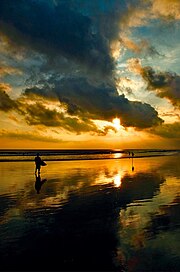Bali's 2007 Q3 Arrivals Up +34.98% over 2006
Total foreign arrivals to Bali for September 2007 totaled 152,532, an improvement of +28.9% over the same month in 2006 (118,331). The "second best September" on record, this year's arrivals were only -6.2% behind the tally for September 2005 when 162,102 arrivals were recorded.
Year to Date
September closed the 3rd quarter with an astounding cumulative total for the year-to-date of 1,229,779 foreign arrivals, making - a full +34.98% better than arrivals through the end of September 2006 (910,996).
Projected Arrivals for Entire 2007
With only three months left in the year, strong booking trends reported by many operators and, in the absence of any untoward events, Bali is likely to end the year with 1.70 million foreign visitors. Should these numbers materialize, Bali will not only have achieved a new record in foreign arrivals for a single year, but also managed to improve its fortune some +71% from the annum horribilis that was 2003 - when only 993,029 foreigners visited Bali in the year immediately following the October 2002 terrorist attack.
A Tale of Two Bombings
As shown on the graphs presented on Balidiscovery.com, the recovery in tourist numbers following the 2005 terrorist bombing took place at a more constant rate and at a higher level than was the case following the 2002 bombing.
Click Image to Enlarge


Bali Arrivals By Market Segments
A glimpse at September arrivals from some of Bali's major source markets yields the following results:
- Japan remained Bali's largest market, producing 36,507 arrivals in September 2007. While representing a +28.46% improvement over September 2006, Japanese arrivals still lag -8.3% behind September 2000 and -21.96% behind the stellar performance of September 2002.
- Australia - arrivals from Oz continue to improve with 21,170 arrivals from down under coming to Bali in September 2007. However, compared to the 32,388 Australians who visited Bali in September 2005, current arrivals would need to improve by some 50% to fully regain past glory.
- Taiwan - At 11,937 Taiwanese arrivals in September 2007, Bali's third largest inbound market is still 20-30% off the strong pace set in 2000 and 2002
- South Korea - With 8.776 visitors from South Korea in September 2007, this market is operating in record territory.
- Malaysia - despite current growing political tensions between Indonesia and Malaysia, a record 7,521 Malaysians came to Bali in September 2007, numbers fueled by low-cost-carriers flying between Kuala Lumpur and Bali.
- The Americas - representing both North and South America, arrivals from that market hit 6,743 in September. Although showing improvement over the performance of the past few years, these figures are still nearly -30% behind the 8,912 visitors recorded from the Americas in September 2000.
- The Netherlands - Holland is firmly back into record territory recording 4,720 visitors to Bali in September 2007.
- United Kingdom - While showing positive improvement over the past few years, the 6,864 U.K. arrivals in September 2007 still suffers from a lack of available airline seats. Compared to arrivals of 12,031 in 2000, U.K. numbers are far behind former levels.
- Germany - A picture of full recovery is demonstrated by the German market which produced 8,386 visitors in September 2007.
- France - presents a similar story of "full recovery" with a record high of 4,891 arrivals in September 2007.





